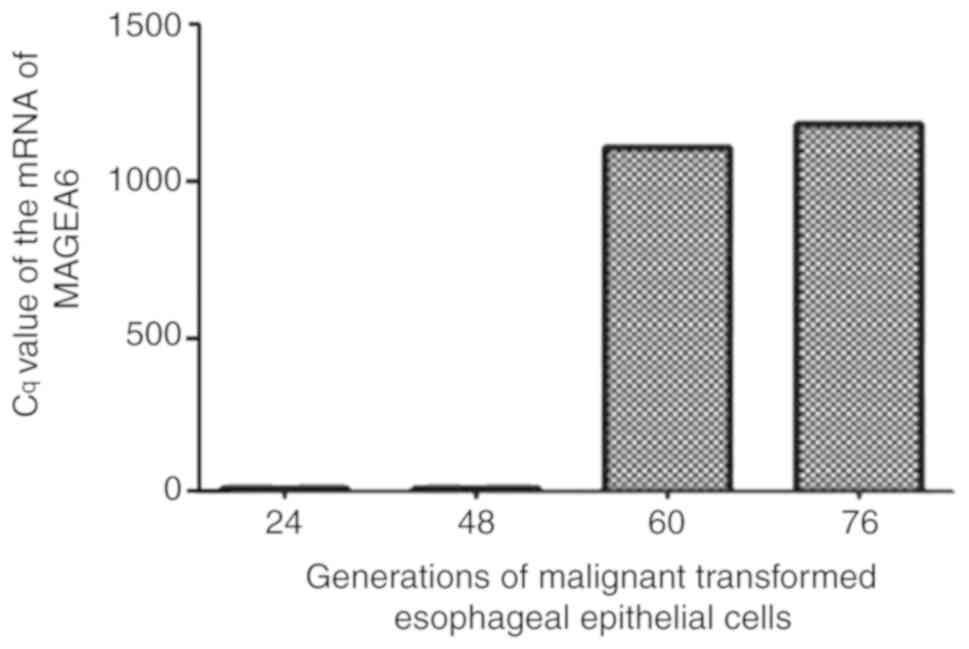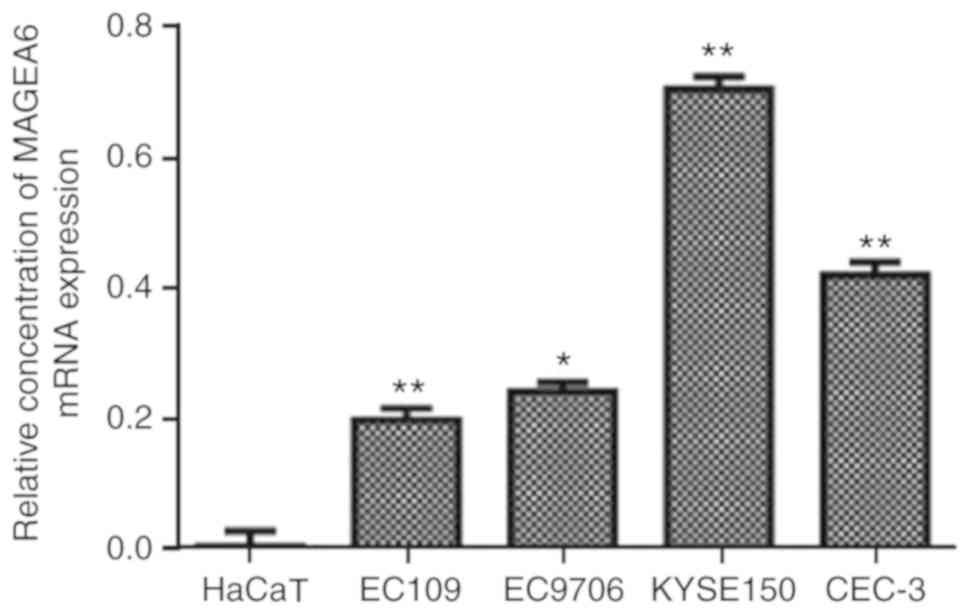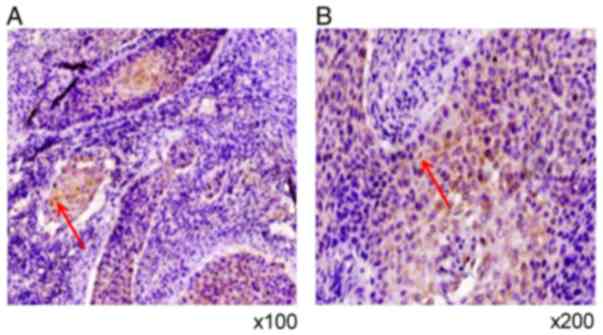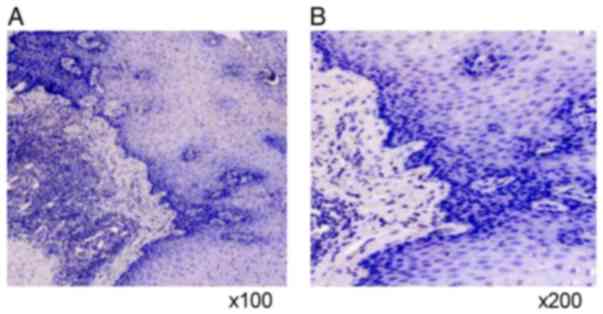|
1
|
Ferlay J, Shin HR, Bray F, Forman D,
Mathers C and Parkin DM: Estimates of worldwide burden of cancer in
2008: GLOBOCAN 2008. Int J Cancer. 127:2893–2917. 2010. View Article : Google Scholar : PubMed/NCBI
|
|
2
|
Zeng Y, Liang W, Liu J, He J, Ng CSH, Liu
CC, Petersen RH, Rocco G, D'Amico T, Brunelli A, et al: Esophageal
cancer in elderly patients: A population-based study. J Thorac Dis.
10:448–457. 2018. View Article : Google Scholar : PubMed/NCBI
|
|
3
|
Domper Arnal MJ, Ferrández Arenas Á and
Lanas Arbeloa Á: Esophageal cancer: Risk factors, screening and
endoscopic treatment in Western and Eastern countries. World J
Gastroenterol. 21:7933–7943. 2015. View Article : Google Scholar : PubMed/NCBI
|
|
4
|
Lei J, Tian Y, Zhu SC, Han Q, Wei Y, Yang
S and Shi DP: Preliminary study of IVIM-DWI and DCE-MRI in early
diagnosis of esophageal cancer. Eur Rev Med Pharmacol Sci.
19:3345–3350. 2015.PubMed/NCBI
|
|
5
|
He F, Liu C, Zhang R, Hao Z, Li Y, Zhang N
and Zheng L: Association between the Glutathione-S-transferase T1
null genotype and esophageal cancer susceptibility: A meta-analysis
involving 11,163 subjects. Oncotarget. 9:15111–15121. 2018.
View Article : Google Scholar : PubMed/NCBI
|
|
6
|
Zakiulla h, Saeed M, Ali S, Javed N,
Khisroon M, Muhammad B, Khuda F, Ahmad S and Ismail M: Genetic
susceptibility to esophageal cancer due to CYP1A1 gene variant
rs4646903 in tobacco addicted patients of Pashtun ethnicity: A case
control study in Khyber Pakhtunkhwa province of Pakistan. Asian Pac
J Cancer Prev. 15:6715–6720. 2014. View Article : Google Scholar : PubMed/NCBI
|
|
7
|
Raja S, Godfrey TE and Luketich JD: The
role of tumor suppressor genes in esophageal cancer. Minerva Chir.
57:767–780. 2002.PubMed/NCBI
|
|
8
|
Zeng R, Liu Y, Jiang ZJ, Huang JP, Wang Y,
Li XF, Xiong WB, Wu XC, Zhang JR, Wang QE and Zheng YF: EPB41L3 is
a potential tumor suppressor gene and prognostic indicator in
esophageal squamous cell carcinoma. Int J Oncol. 2018.
|
|
9
|
Shibata-Kobayashi S, Yamashita H, Okuma K,
Shiraishi K, Igaki H, Ohtomo K and Nakagawa K: Correlation among 16
biological factors [p53, p21(waf1), MIB-1 (Ki-67), p16(INK4A),
cyclin D1, E-cadherin, Bcl-2, TNF-alpha, NF-kappaB, TGF-beta,
MMP-7, COX-2, EGFR, HER2/neu, ER, and HIF-1alpha] and clinical
outcomes following curative chemoradiation therapy in 10 patients
with esophageal squamous cell carcinoma. Oncol Lett. 5:903–910.
2013. View Article : Google Scholar : PubMed/NCBI
|
|
10
|
van der Bruggen P, Traversari C, Chomez P,
Lurquin C, De Plaen E, Van den Eynde B, Knuth A and Boon T: A gene
encoding an antigen recognized by cytolytic T lymphocytes on a
human melanoma. Science. 254:1643–1647. 1991. View Article : Google Scholar : PubMed/NCBI
|
|
11
|
Zou C, Shen J, Tang Q, Yang Z, Yin J, Li
Z, Xie X, Huang G, Lev D and Wang J: Cancer-testis antigens
expressed in osteosarcoma identified by gene microarray correlate
with a poor patient prognosis. Cancer. 118:1845–1855. 2012.
View Article : Google Scholar : PubMed/NCBI
|
|
12
|
Lee TB, Lim SC, Moon YS and Choi CH:
Melanoma antigen gene family A as a molecular marker of gastric and
colorectal cancers. Oncol Rep. 30:234–238. 2013. View Article : Google Scholar : PubMed/NCBI
|
|
13
|
Yang Y and Fa X: Role of IL-10 gene
polymorphisms on the susceptibility for esophageal cancer and its
association with environmental factors. Int J Clin Exp Pathol.
8:9580–9585. 2015.PubMed/NCBI
|
|
14
|
Zang B, Huang G, Wang X and Zheng S:
HPV-16 E6 promotes cell growth of esophageal cancer via
downregulation of miR-125b and activation of Wnt/β-catenin
signaling pathway. Int J Clin Exp Pathol. 8:13687–13694.
2015.PubMed/NCBI
|
|
15
|
Sarkar J, Dominguez E, Li G, Kusewitt DF
and Johnson DG: Modeling gene-environment interactions in oral
cavity and esophageal cancers demonstrates a role for the p53 R72P
polymorphism in modulating susceptibility. Mol Carcinog.
53:648–658. 2014.PubMed/NCBI
|
|
16
|
Chen YT, Panarelli NC, Piotti KC and
Yantiss RK: Cancer-testis antigen expression in digestive tract
carcinomas: Frequent expression in esophageal squamous cell
carcinoma and its precursor lesions. Cancer Immunol Res. 2:480–486.
2014. View Article : Google Scholar : PubMed/NCBI
|
|
17
|
Shen ZY, Cen S, Xu LY, Cai WJ, Chen MH,
Shen J and Zeng Y: E6/E7 genes of human papilloma virus type 18
induced immortalization of human fetal esophageal epithelium. Oncol
Rep. 10:1431–1436. 2003.PubMed/NCBI
|
|
18
|
Shen ZY, Xu LY, Li EM, Cai WJ, Chen MH,
Shen J and Zeng Y: Telomere and telomerase in the initial stage of
immortalization of esophageal epithelial cell. World J
Gastroenterol. 8:357–362. 2002. View Article : Google Scholar : PubMed/NCBI
|
|
19
|
Shen ZY, Xu LY, Li EM, Cai WJ, Shen J,
Chen MH, Cen S, Tsao SW and Zeng Y: The multistage process of
carcinogenesis in human esophageal epithelial cells induced by
human papillomavirus. Oncol Rep. 11:647–654. 2004.PubMed/NCBI
|
|
20
|
Shen ZY, Xu LY, Chen MH, Cai WJ, Shen J,
Chen JY and Zeng Y: Cytogenetic and molecular genetic changes in
malignant transformation of immortalized esophageal epithelial
cells. Int J Mol Med. 12:219–224. 2003.PubMed/NCBI
|
|
21
|
Livak KJ and Schmittgen TD: Analysis of
relative gene expression data using real-time quantitative PCR and
the 2(-Delta Delta C(T)) method. Methods. 25:402–408. 2001.
View Article : Google Scholar : PubMed/NCBI
|
|
22
|
Arantes V and Espinoza-Ríos J: Early
esophageal squamous cell carcinoma management through endoscopic
submucosal dissection. Rev Gastroenterol Mex. 83:259–267. 2018.(In
English, Spanish). PubMed/NCBI
|
|
23
|
Chen L, Deng H, Lu M, Xu B, Wang Q, Jiang
J and Wu C: B7-H1 expression associates with tumor invasion and
predicts patient's survival in human esophageal cancer. Int J Clin
Exp Pathol. 7:6015–6023. 2014.PubMed/NCBI
|
|
24
|
Jenkins TK, Lopez AN, Sarosi GA, Ben-David
K and Thomas RM: Preoperative enteral access is not necessary prior
to multimodality treatment of esophageal cancer. Surgery.
163:770–776. 2018. View Article : Google Scholar : PubMed/NCBI
|
|
25
|
Nayan N, Bhattacharyya M, Jagtap VK,
Kalita AK, Sunku R and Roy PS: Standard-dose versus high-dose
radiotherapy with concurrent chemotherapy in esophageal cancer: A
prospective randomized study. South Asian J Cancer. 7:27–30.
2018.PubMed/NCBI
|
|
26
|
Weon JL and Potts PR: The MAGE protein
family and cancer. Curr Opin Cell Biol. 37:1–8. 2015. View Article : Google Scholar : PubMed/NCBI
|
|
27
|
Cogdill AP, Frederick DT, Cooper ZA,
Garber HR, Ferrone CR, Fiedler A, Rosenberg L, Thayer SP, Warshaw
AL and Wargo JA: Targeting the MAGE A3 antigen in pancreatic
cancer. Surgery. 152 (3 Suppl 1):S13–S18. 2012. View Article : Google Scholar : PubMed/NCBI
|
|
28
|
Lin J, Lin L, Thomas DG, Greenson JK,
Giordano TJ, Robinson GS, Barve RA, Weishaar FA, Taylor JM,
Orringer MB and Beer DG: Melanoma-associated antigens in esophageal
adenocarcinoma: Identification of novel MAGE-A10 splice variants.
Clin Cancer Res. 10:5708–5716. 2004. View Article : Google Scholar : PubMed/NCBI
|
|
29
|
Park TS, Groh EM, Patel K, Kerkar SP, Lee
CC and Rosenberg SA: Expression of MAGE-A and NY-ESO-1 in primary
and metastatic cancers. J Immunother. 39:1–7. 2016. View Article : Google Scholar : PubMed/NCBI
|


















